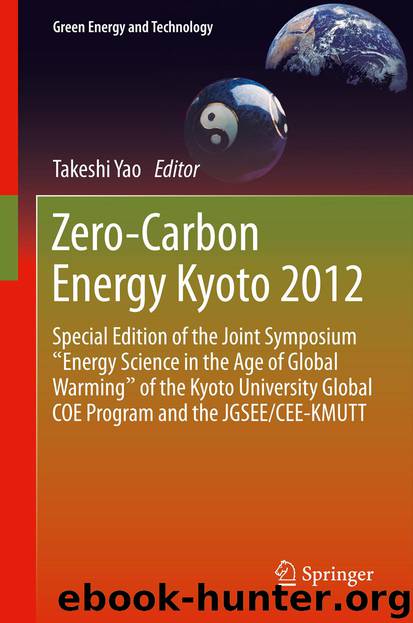Zero-Carbon Energy Kyoto 2012 by Takeshi Yao

Author:Takeshi Yao
Language: eng
Format: epub
Publisher: Springer Japan, Tokyo
Keywords
ElectrospinningNanofiberStrontium titanate
1 Introduction
The photocatalytic properties of metal oxide semiconductors have been widely studied. Titanium dioxide (TiO2) has seen the most interest because of its water-splitting capability due to its photostability, availability, low cost, non-toxicity and its electronic properties [1, 2]. For water-splitting applications however, the position of the valence band level and the rather large band gap of TiO2 has inhibited its catalytic performance under visible light. Modification of TiO2 with the addition of strontium to form strontium titanate (SrTiO3), a perovskite, has been shown to improve the photopotential of TiO2, allow the production of both hydrogen and oxygen in water-splitting due to the position of the valence and conduction band of SrTiO3, and facilitate easier doping for electronic modification [3]. However, the fabrication of SrTiO3 nanofibers via the hydrothermal reaction of electrospun TiO2 nanofibers with strontium hydroxide has led to various forms of strontium–titanium heterostructures [4, 5]. In this work, we prepared homogeneous SrTiO3 nanofibers via the electrospinning of a solution, which included both titanium and strontium precursors. The precursor solution was modified from the previously reported and optimized TiO2 precursor solution [6].
Download
This site does not store any files on its server. We only index and link to content provided by other sites. Please contact the content providers to delete copyright contents if any and email us, we'll remove relevant links or contents immediately.
| Automotive | Engineering |
| Transportation |
Whiskies Galore by Ian Buxton(41881)
Introduction to Aircraft Design (Cambridge Aerospace Series) by John P. Fielding(33064)
Small Unmanned Fixed-wing Aircraft Design by Andrew J. Keane Andras Sobester James P. Scanlan & András Sóbester & James P. Scanlan(32743)
Craft Beer for the Homebrewer by Michael Agnew(18142)
Turbulence by E. J. Noyes(7937)
The Complete Stick Figure Physics Tutorials by Allen Sarah(7309)
Kaplan MCAT General Chemistry Review by Kaplan(6867)
The Thirst by Nesbo Jo(6829)
Bad Blood by John Carreyrou(6553)
Modelling of Convective Heat and Mass Transfer in Rotating Flows by Igor V. Shevchuk(6391)
Learning SQL by Alan Beaulieu(6211)
Weapons of Math Destruction by Cathy O'Neil(6147)
Man-made Catastrophes and Risk Information Concealment by Dmitry Chernov & Didier Sornette(5922)
Digital Minimalism by Cal Newport;(5665)
Life 3.0: Being Human in the Age of Artificial Intelligence by Tegmark Max(5474)
iGen by Jean M. Twenge(5366)
Secrets of Antigravity Propulsion: Tesla, UFOs, and Classified Aerospace Technology by Ph.D. Paul A. Laviolette(5309)
Design of Trajectory Optimization Approach for Space Maneuver Vehicle Skip Entry Problems by Runqi Chai & Al Savvaris & Antonios Tsourdos & Senchun Chai(5011)
Pale Blue Dot by Carl Sagan(4913)
